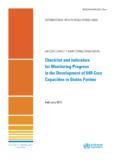Transcription of ASSESSMENT OF CORE CAPACITIES AT POINTS OF ENTRY, SRI ...
1 1 2 ASSESSMENT OF CORE CAPACITIES AT POINTS OF ENTRY, SRI lanka TO implement international health regulations (2005) Directorate of Quarantine Ministry of health , Sri lanka Supported by the international Organization for Migration (IOM) 2013 3 Contents ACKNOWLEDGMENTS .. 5 EXECUTIVE SUMMARY .. 6 INTRODUCTION .. 7 COUNTRY BACKGROUND .. 8 OBJECTIVES OF THE ASSESSMENT .. 10 METHOD 11 FINDINGS OF THE ASSESSMENT .. 13 Core capacity 1: National legislation, policy and financing .. 13 Core capacity 2: Coordination and NFP communications .. 18 Core capacity 3: Surveillance .. 20 1. Rapid detection.
2 21 2. Risk ASSESSMENT .. 24 3. Alert/Notification .. 25 Core capacity 4: Response .. 27 Core capacity 5: Preparedness .. 29 Core capacity 6: Risk communication .. 30 Core capacity 7: Human resources .. 31 Core capacity 8: Laboratory .. 32 36 REFERENCES .. 38 4 AIRPORTS AND SEAPORTS IN SRI lanka 5 ACKNOWLEDGMENTS The ASSESSMENT of the core CAPACITIES at POINTS of entry in Sri lanka to implement international health regulations (2005) for the Ministry of health , Sri lanka was carried out with the generous technical and logistical support of the international Organization for Migration (IOM).
3 The contribution made by all stakeholders from the Ministry of health , other Government Ministries and Agencies who participated in the ASSESSMENT are remembered with gratitude. The ASSESSMENT was carried out by Dr Vindya Kumarapeli, Consultant Community Physician, Ministry of health . The contribution made by the following individuals is gratefully acknowledged: Dr L B H Denuwara, Director (Quarantine), Ministry of health Dr Kolitha Wickramage, Head of health Programs, international Organization for Migration Dr Sharika Peiris, National Professional Officer (Migration health ), international Organization for Migration Dr Iresh Dassanayaka, Consultant Community Physician, Directorate of Quarantine Dr Sepali Wickramathilaka, Consultant Community Physician, Directorate of Quarantine Sirisena, Chief Port health Officer, Port health Office, Colombo Dr.
4 F .D. Colombage, Chief Port health Officer, Port health Office, Galle Port Dr. Sanjeeva Siriwardana, Chief Airport health Officer, Bandaranaike international Airport Mr. Jayatissa Nanayakkara, Public health Inspector, Port health Officer, Galle Port Mr. W. P. Chandrasiri, Public health Inspector, Air Port health Office, Bandaranaike international Airport Mr. S. Udayanga, Development Officer, Port health Office, Galle port. 6 EXECUTIVE SUMMARY The emergence and re-emergence of infectious diseases and threats of deliberate use of biological and chemical agents have emerged as threats to public health security.
5 Increased international air travel, has caused spread of infectious disease across the globe faster and farther, best illustrated by the outbreaks of SARS in 2003 and Influenza A in 2009. The international health regulations are a set of legally binding regulations , for the World health Organization Member States to guide prevention and control of public health hazards: biological (infectious, zoonotic, food born), chemical and radio-nuclear material, manifested by imported or exported human cases, infected or contaminated vectors or contaminated goods, which may cause a public health emergency of international concern (PHEIC).
6 Increasing international migration flow in the present day emphasises the need to strengthen the POINTS of entry (POE) to Sri lanka , adhering to domestic and international legislations and avoiding unnecessary interference with international traffic and trade. The eight core CAPACITIES at the POE needed to detect, assess, notify and respond to a public health emergency were evaluated in September 2013 by the Directorate for Quarantine. A desk review of domestic and international laws, regulations and literature was carried out at the outset. The protocol developed by the WHO was used in developing the check list.
7 Services related to IHR (2005) core CAPACITIES : human resources, infrastructure (general), financial, networking with other agencies (mechanism), and training related to IHR were assessed in component I. The eight core capacity requirements: national legislation and policy, coordination and NFP communications, surveillance, response, preparedness, risk communication, human resource, laboratory and capacity were assessed in component II. ASSESSMENT was done through field visits, observations and key informant interviews with relevant stakeholders from health and non- health sectors.
8 In addition, data compiled at the Port health Offices were analysed to assess relevant indicators. The major system and service gaps identified under each core capacity are given in Table 2 Mapping of current practices at POE including stakeholders and resources was done and a gap analysis was performed using IHR (2005) core capacity requirements as best practices for POE. Findings of this report will provide evidence to build an innovative strategy to face the modern challenges due to the changing dynamics of international travel and disease epidemiology.
9 7 INTRODUCTION The international Sanitary regulations , first adopted in 1951 were renamed as the international health regulations (IHR) in 1969. The 1951 IHR intended to monitor and control only six serious infectious diseases: cholera, plague, yellow fever, smallpox, relapsing fever and typhus. Developments in international ship/aircraft traffic affected the international transmission of disease and in May 2005, the World health Assembly adopted a revised IHR which entered into force in June 2007. The IHR (2005) identifies five human health hazards : (a) biological-infectious diseases, zoonotic diseases, contaminated food (b)chemical agents, (c) nuclear and radioactive material and) which may cause a public health emergency of international concern (PHEIC) as manifested by imported or exported human cases, infected or contaminated vectors, or contaminated goods.
10 The emergence and re-emergence of infectious diseases, threat of deliberate use of biological and chemical agents etc, have highlighted the need to strengthen POINTS of entry while adhering to domestic and international legislations (IHR 2005). The core CAPACITIES are the CAPACITIES needed to detect, assess, notify and report and respond to public health events (events or emergencies) of national and international concern. developed by a technical group of experts of WHO. The core CAPACITIES enable effective application of health measures to prevent international spread of diseases.

